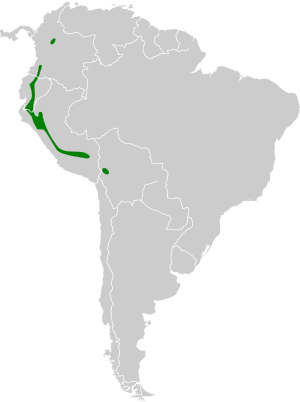Green-tailed trainbearer facts for kids
Quick facts for kids Green-tailed trainbearer |
|
|---|---|
 |
|
| Conservation status | |
| Scientific classification | |
| Genus: |
Lesbia
|
| Species: |
nuna
|
 |
|
| Range of Lesbia nuna | |
The green-tailed trainbearer (Lesbia nuna) is a super cool type of hummingbird! These tiny birds are known for their amazing long tails, especially the males. You can find them living in countries like Bolivia, Colombia, Ecuador, Peru, and maybe even Venezuela.
Contents
About the Green-Tailed Trainbearer
How Scientists Classify Them
Scientists have different ways of organizing and naming animals, which is called taxonomy. For the green-tailed trainbearer, there are a few ideas about how to group them. The International Ornithological Committee (IOC) says there are six main types, or subspecies, of this bird. Other groups, like the Clements taxonomy, recognize a seventh type. It's a bit like different clubs having slightly different rules for their members!
Even though the green-tailed trainbearer shares its family name (Lesbia) with the black-tailed trainbearer, they might not be super close relatives. Scientists are always learning more about how different species are connected.
What They Look Like
The male green-tailed trainbearer is about 15 to 17 centimeters (6 to 7 inches) long. A big part of that length is its super long tail, which can be up to 13.6 centimeters (5.4 inches) long! Females are a bit smaller, around 11.6 centimeters (4.6 inches) long, with shorter tails. These birds are very light, weighing only about 3 to 4 grams (0.1 to 0.15 ounces). That's less than a few paper clips!
They have a short, straight, black beak. Males are mostly a shiny emerald green color. Their throat is a bright, shimmering green, and their belly is grayish with green dots. Their long, forked tail is black with cool green tips on the feathers.
Female green-tailed trainbearers look similar but have white underparts with sparkling green spots. Their tails are shorter than the males'. Young birds look a lot like the adult females. Young males also have green spots on their throats.
Different types (subspecies) of the green-tailed trainbearer have slight differences. For example, some might be smaller, have different colored bellies, or have slightly different shades of green on their feathers.
Where They Live and Their Home
The green-tailed trainbearer lives in the Andes mountains across several South American countries.
- L. n. gouldii lives in the Andes of northeastern and southern Colombia.
- L. n. gracilis is found in the Andes of northern and central Ecuador.
- L. n. aureliae lives in the Andes of southeastern Ecuador.
- L. n. pallidiventris is found in the Andes of northern and central Peru.
- L. n. huallagae lives in the Huallaga River valley in central Peru.
- L. n. nuna is found in the Andes of southwestern Peru and northern Bolivia.
These birds usually live in places with secondary woodland (forests that have grown back after being cut down) and bushy hillsides. They also like Polylepis woodlands and high-altitude grasslands called páramo. You can find them at elevations from about 1,700 to 3,800 meters (5,600 to 12,500 feet) above sea level.
Green-Tailed Trainbearer Behavior
Movement
Scientists are still learning about how the green-tailed trainbearer moves around. It's likely that they change their elevation, moving higher or lower in the mountains, especially after their breeding and flowering seasons.
What They Eat
The green-tailed trainbearer loves to drink nectar from flowers. They usually look for nectar at low to medium heights in the plants. They've been seen sipping nectar from flowers like Castilleja fissifolia and Rubus. Besides nectar, they also eat insects. They catch insects while flying or pick them off flowers.
Reproduction and Life Cycle
The breeding season for the green-tailed trainbearer is from November to April. They build a cup-shaped nest using moss and small roots. They line the inside with soft plant materials to make it cozy. These nests are usually placed under an overhang on a slope, about 2 to 4 meters (6 to 13 feet) above the ground.
A female green-tailed trainbearer usually lays two eggs. Scientists haven't yet recorded how long it takes for the eggs to hatch or for the young birds to leave the nest.
Sounds They Make
The green-tailed trainbearer has a special song that sounds like a repeated, gravelly "drrrt...drrrt..." They also make calls, like a buzzing "bzzzzt" or a fast series of high-pitched notes such as "tseee...tseee...tseee..tsee-tsi-tsi." When they are showing off, they can even make a snapping sound with their tail or wings!
Their Status in the Wild
The International Union for Conservation of Nature (IUCN) says the green-tailed trainbearer is a species of "Least Concern." This means they are not currently in danger of disappearing. They live in a large area, and even though we don't know exactly how many there are, their population seems to be stable.
For now, there aren't any big, immediate threats to these birds. However, things like forests being cut down (especially Polylepis woodlands), ranching, and farming could become problems in the future.
See also
 In Spanish: Colibrí colilargo menor para niños
In Spanish: Colibrí colilargo menor para niños


